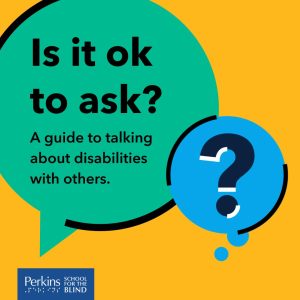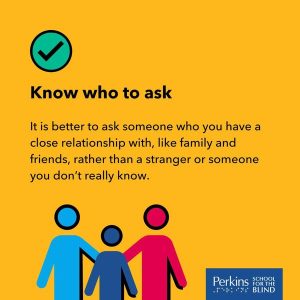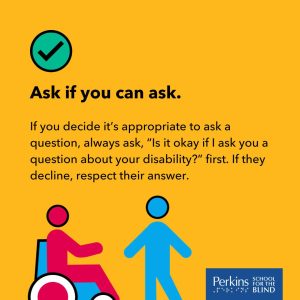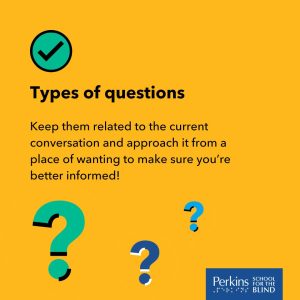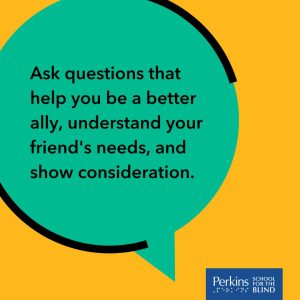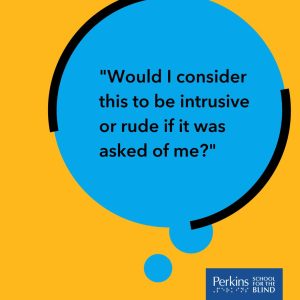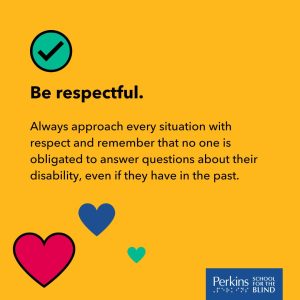Part 3: Writing About Disability
Learning Objectives
By the end of this section, you will be able to:
- identify and avoid problematic language choices related to disability.
- articulate why word choices in general should be deliberate and considered.
Why Should We Write about Disability?
The act of writing is one of the ways humans communicate with each other. We use it both to persuade others and, in some ways, persuade ourselves of our ideas as we work them out through written expression. Writing of different kinds is everywhere – in news articles and journalistic reports, in social media, in films and literature, in government laws and legal documents, even in speeches and oral presentations. How disability is presented in all of these ways is important. It affects how people are treated and how they are perceived, but it also affects how people see themselves. Not writing about disability has the effect of erasing people with disabilities. Writing about disability in misinformed or disrespectful ways reinforces stereotypes and impedes progress.
“The complexity of human experience is truly amazing, and when we constrain ourselves, or our characters, into narrow paths, we miss opportunities. Writing is one medium we use to sort out these complexities and express the full spectrum of human existence. Being a conscientious and careful writer includes acknowledging the variety of humanity even if we do not share in a particular identity. When you think of identity, what comes to mind? Race, religion, ethnicity? Age? Gender? One element often ignored is disability. Disability, like any other marginalized identity, has its challenges and its joys. As with any marginalized identity, it is important to listen to and center disabled people. In the 1990s, the Disability Rights Movement (DRM) embraced the slogan ‘Nothing About Us Without Us.’ Elaborated by two South African disability activists, the slogan encourages everyone to include and center the marginalized community within their work. The DRM message was, and is, in direct opposition to how disabled people are generally treated by the non-disabled, which is often that their accomplishments are viewed only as motivational messages for abled people. ‘Inspiration porn’ (coined by disability activist Stella Young) is the objectification of disabled people as inspirations for abled people. The veteran is ‘so brave’ for walking with her prosthesis. The intellectually disabled child is ‘so amazing’ for graduating from high school. We, as abled people, have ‘no excuses’ not to exercise when we see a disabled athlete killing a workout. Reducing people to their disability and then using that disability to “motivate” the abled is essentializing and stereotyping. Writers have a unique space within which to examine and critique the historical silencing of disability, and to compose new, more comprehensive, narratives. When we write, we offer unique perspectives on lived experiences and we have the ability to find commonality in difference, to offer intersectional paths. One that values ALL bodies and minds. Do not be afraid to be your whole self or allow others to be their full selves. Recognize ways in which ableism affects you and those around you. Be intersectional; know that race, class, ethnicity, age, and disability interact in varied ways in this world. And write about it!” — Dr. Kimberly Klimek, History, Metropolitan State University of Denver
View: “Should schools teach disability history?”
How Should We Write about Disability?
ADA Guidelines for Writing About People With Disabilities
Words are powerful.
The words you use and the way you portray individuals with disabilities matters. This factsheet provides guidelines for portraying individuals with disabilities in a respectful and balanced way by using language that is accurate, neutral and objective.
- Ask to find out if an individual is willing to disclose their disability.
Do not assume that people with disabilities are willing to disclose their disability. While some people prefer to be public about their disability, such as including information about their disability in a media article, others choose to not be publically identified as a person with a disability.
- Emphasize abilities, not limitations.
Choosing language that emphasizes what people can do instead of what they can’t do is empowering.
| Use | Don’t Use |
| Person who uses a wheelchair | Wheelchair-bound; confined to a wheelchair |
| Person who uses a communication device; uses an alternative method of communication | Is non-verbal; can’t talk |
- In general, refer to the person first and the disability second.
People with disabilities are, first and foremost, people. Labeling a person equates the person with a condition and can be disrespectful and dehumanizing. A person isn’t a disability, condition or diagnosis; a person has a disability, condition or diagnosis. This is called Person-First Language.
| Use | Don’t Use |
| Person with a disability, people with disabilities | Disabled person; the disabled |
| Man with paraplegia | Paraplegic; paraplegic man |
| Person with a learning disability | Slow learner |
| Student receiving special education services | Special education student |
| A person of short stature or little person | Dwarf, midget |
- However, always ask to find out an individual’s language preferences.
People with disabilities have different preferences when referring to their disability. Some people see their disability as an essential part of who they are and prefer to be identified with their disability first – this is called Identity-First Language. Others prefer Person-First Language. Examples of Identity-First Language include identifying someone as a deaf person instead of a person who is deaf, or an autistic person instead of a person with autism.
- Use neutral language.
Do not use language that portrays the person as passive or suggests a lack of something: victim, invalid, defective.
| Use | Don’t Use |
| Person who has had a stroke | Stroke victim |
| Congenital disability | Birth defect |
| Person with epilepsy | Person afflicted with epilepsy, epileptic |
| Person with a brain injury | Brain damaged, brain injury sufferer |
| Burn survivor | Burn victim |
- Use language that emphasizes the need for accessibility rather than the presence of a disability.
| Use | Don’t Use |
| Accessible parking | Handicapped parking |
| Accessible restroom | Disabled restroom |
Note that ‘handicapped’ is an outdated and unacceptable term to use when referring to individuals or accessible environments.
- Do not use condescending euphemisms.
Terms like differently-abled, challenged, handi-capable or special are often considered condescending.
- Do not use offensive language.
Examples of offensive language include freak, retard, lame, imbecile, vegetable, cripple, crazy, or psycho.
- Describing people without disabilities.
In discussions that include people both with and without disabilities, do not use words that imply negative stereotypes of those with disabilities.
| Use | Don’t Use |
| People without disabilities | Normal, healthy, able-bodied, whole |
| She is a child without disabilities | She is a normal child |
- Remember that disability is not an illness and people with disabilities are not patients.
People with disabilities can be healthy although they may have a chronic condition such as arthritis or diabetes. Only refer to someone as a patient when his or her relationship with a health care provider is under discussion.
- Do not use language that perpetuates negative stereotypes about psychiatric disabilities.
Much work needs to be done to break down stigma around psychiatric disabilities. The American Psychiatric Association has new guidelines for communicating responsibly about mental health.
| Use | Don’t Use |
| He has a diagnosis of bipolar disorder; he is living with bipolar disorder | He is (a) bipolar; he is (a) manic-depressive |
| Attempted suicide | Unsuccessful suicide |
| Died by suicide | Committed suicide |
| Is receiving mental health services | Mental Health patient/case |
| Person with schizophrenia | Schizophrenic, schizo |
| Person with substance use disorder; person experiencing alcohol/drug problem | Addict, abuser; junkie |
| She has a mental health condition or psychiatric disability | She is mentally ill/emotionally disturbed/ insane |
- Portray successful people with disabilities in a balanced way, not as heroic or superhuman.
Do not make assumptions by saying a person with a disability is heroic or inspiring because they are simply living their lives. Stereotypes may raise false expectations that everyone with a disability is or should be an inspiration. People may be inspired by them just as they may be inspired by anyone else. Everyone faces challenges in life.
- Do not mention someone’s disability unless it is essential to the story.
The fact that someone is blind or uses a wheelchair may or may not be relevant to the article you are writing. Only identify a person as having a disability if this information is essential to the story. For example, say “Board president Chris Jones called the meeting to order.” Do not say, “Board president Chris Jones, who is blind, called the meeting to order.” It’s ok to identify someone’s disability if it is essential to the story. For example, “Amy Jones, who uses a wheelchair, spoke about her experience with using accessible transportation.”
- Create balanced human-interest stories instead of tear-jerking stories.
Tearjerkers about incurable diseases, congenital disabilities or severe injury that are intended to elicit pity perpetuate negative stereotypes.
Text Attributions
This section contains material taken from “Guidelines for Writing About People With Disabilities,” which may be reproduced and distributed freely with attribution to ADA National Network.
- (Images with permission of Perkins School for the Blind)
Inspiration Porn
“Inspiration porn” is a phrase coined by Australian disability activist Stella Young to describe a tendency to use images or stories of people with disabilities to indicate that non-disabled people “should be able” to do something if a person with a disability can do it. This type of representation is often to motivate others, rather than highlight people with disabilities. We can especially see “inspiration porn” at work in media coverage of events such as the Paralympics.
View: “I’m not your inspiration, thank you very much”
Excerpt of “Inspiration Porn’”
by Marissa Ladderbush, Student, Fitchburg State University
Throughout the semester, my classmates and I have touched on several different topics pertaining to disability, including different types of prejudice, what type of language should and should not be used, and inspiration porn. All of these topics allowed many of us to gain insight that we most likely would not be introduced to within our college careers. Throughout the discussions of these topics, inspiration porn seemed to resonate the most with me because of how misunderstood it is by many people. Though there is not a specific definition for inspiration porn, I hope giving examples throughout history will encourage viewers to better understand what it is and more specifically how to avoid participation.
Starting with premodern examples of inspiration porn, we are brought to the late 1100’s with Saint Mary of Oegines. Mary was a religious public figure in Nivelles, and battled with mental illnesses throughout her life. As told by Kisha Tracy and Alicia Protze, Mary struggled with a handful of different self harming tendencies: “In her Life, St. Mary of Oegines is described as self-harming, especially through fasts to the point of destroying her body, cutting, and suffering of excessive weeping and mood shifts.” While dealing with these, Mary believed that they in fact made her closer to God and were in a sense health habits for her.
An example of Mary’s mood swings are perfectly depicted when she is told by a priest that her weeping is deemed as unnecessary, but she claims that she could not help herself from weeping because of the immense compassion she felt for God’s suffering. Mary would often place herself in God’s shoes and push herself past unhealthy boundaries to show her devotion, such as cutting the bottom of her feet and fasting for upwards of a month. An example of her undying devotion with cutting her feet is described by Tracy and Protze: “Mary, after walking through a town which filled her mind with sin, cuts herself,”asking for a knife from her maid, when she was outside the town, would have cut the skin from her feet”. It is to a certain extent an individual mimicking of Christ’s wounds, and, if so, then Mary’s cutting is presented as a holy act of cleansing” (220). This type of “religious” behavior is commonly known as affective piety. Mary’s struggle with affective piety was perceived by society as her being devoted and as a role model.
Being a role model within her society back in the 1100’s allows us as viewers to make the connection that Mary’s life can be viewed as inspiration porn. Though the term “inspiration porn” was not considered at the time Mary was still alive, we now realize that all of her personal destructive ways were in fact seen as accomplishments of sainthood by outsiders.
The next public figure we can discuss is Perla Ovici and her family. The Ovici family barely lived through the horrors of the Holocaust in the concentration camp at Auschwitz. As told in my artifact entry, their family consisted of: “a family of twelve, with 9 siblings, 6 of which were dwarves and 3 were averaged sized people. Her mother, Batia, was an average sized woman, while her father, Shimshon Eizik, had dwarfism.” Having dwarfism, being Jewish, and living in Hungary, which was then taken over by Germany, was an extremely lethal combination for any family. So how were they able to survive years in the inhumane concentration camp?
The answer lies within Dr. Josef Mengele, who was an experimental doctor at Auschwitz. Mengele had a scientific obsession, as well as more inappropriate ones too, with the younger Ovici girls. This obsession seemed to generate from Hitler’s fascination with those who had dwarfism, making Mengele want to impress Hitler with this family. An excerpt from my catalog can give us better insight on this matter: “The angry voice Perla and her family heard was Dr. Josef Mengele, also known as the “Angel of Death”’‘The infatuation with Perla and her family from Dr. Josef Mengele escalated quickly and was very intense. He would do bizarre and disturbing experiments on each and every one of them, inflicting intolerable pain as if it were his second nature. Mengele would bring them to the breaking point, let them recover, all to do it again in a few days. Some experiments included the injection of chemicals straight into their eyes, blinding them, as well as for the women, having their uterus’ scraped and pierced for many unknown reasons.” There was no clear reasoning for these experiments, and Mengele never explained what data he genuinely wanted to collect.
Aside from the scientific reasoning that the Ovici’s were allowed to live, they were also used for entertainment for the soldiers because of their musical background. Before being sent off, the Ovicis managed their group called the Lilliput Troupe, which was another reason they were kept alive for so long.
Now to relate this to the term of inspiration porn, we must find the deeper connections. Well, since there is no true definition of inspiration porn, it truly is up to the viewer to interpret just where they fall in this “category.” In my own opinion, the Ovici’s were most certainly used as inspiration porn for a multitude of reasons.
The first reason is that they survived Auschwitz by being prioritized and favorited by a higher power. This power was Josef Mengele, and even though he poked and prodded the undeserving family, he still made them feel as though they were special and a part of his family. In the documentary Liebe Perla, Perla states: “If the judges had asked me if he should be hanged, I’d have told them to let him go,” she recalled. “I was saved by the grace of the devil; God will give Mengele his due” (Kelly). This shows the hold that Mengele had on the family, as well as how he “saved” them. Being shown kindness by a Nazi while being Jewish was nearly impossible, but the Ovici’s were spared because of their disability.
Another way the Ovici family was used as inspiration porn was in a documentary that was created around Perla and her survival. Thousands of other Jewish prisoners made it out of the concentration camps alive, yet very few were taken interest in and had their stories shared. Was Perla chosen because of her disability? Was it because of the fact that Dr. Mengele took special interest in her family? Or was it both? These are the questions we absolutely must take under consideration when we put a spotlight on individuals no matter what their status in life.
In order to take matters under consideration, we must also find ways to avoid inspiration porn zzz via social media or any type of public outlet. Since I am not an expert on how to avoid inspiration porn, and no one is, I turned to an article from Forbes magazine. This article by Andrew Pulrang gives a few examples that can steer writers or anybody in a better path when talking about disability. The first insightful advice Pulrang gives us is: “Stories about disability should always include ideas, impressions, and/or direct quotations from actual disabled people. There is simply no excuse not to. If a particular disability makes communication difficult, use whatever tools work best for them. If meaningful inclusion of disabled people isn’t possible, for whatever reason, then don’t do the story.” This quotation shows the dire importance of how those with disabilities must have a say in any type of piece that is created around them, otherwise it is not authentic and can be fabricated in a way that is insulting or incorrect.
The next piece of advice Andrew Pulrang shares with us may be one of the most important “guidelines”, and it is one that I most certainly try to consider with when writing. It states, “Don’t speak of disability as an affliction, a burden, or a tragedy. Don’t talk about disabled adults as if they are children, and never refer to the idea of someone having a “mental age” less than their chronological age. Give a realistic picture of what disability entails, but don’t over-dramatize it, and remember to also show the tools and supports the disabled person uses every day to function.” Within writing pieces it should never be made a point that those who have disabilities are at a disadvantage, because they most certainly are not.
The simple fact of the matter is that everyone lives their lives in different ways, so why should it be seen as a tragedy if those who are disabled utilize different equipment or have other ways to create solutions? As a society it is imperative that we treat everyone as equals, and especially we must produce media that is accurate and not insensitive or embellished.
Discussion 3.3
- In looking at the language “use/don’t use” suggestions from the “Guidelines for Writing About People With Disabilities,” why should we use one over the other?
- Why is inspiration porn an issue? Can you think of any examples of inspiration porn?
Writing in Braille
It is important also to think about different styles of writing. Braille Brain, for instance, is a “free website-based, self-paced curriculum to help people who already have literacy skills learn braille.”

